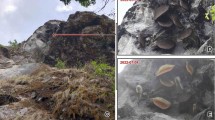Summary
Leptothorax pergandei, the only member of the subgenusDichothorax, is a common ant in Chihuahuan desert habitats in southwestern Arizona. According to colony censuses and relatedness estimates, colonies are mostly monogynous and queens typically mate only once. Mating takes place in local swarming flights; virgin queens attract males with secretions from the poison gland. Some dealate queens running on the soil surface directly after the mating flight had well-developed ovaries containing mature eggs and yellow bodies.
Similar content being viewed by others
References
Bourke, A. F. G., T. M. van der Have and N. R. Franks, 1988. Sex ratio determination and worker reproduction in the slave-making antHarpagoxenus sublaevis.Behav. Ecol. Sociobiol. 23:233–245.
Buschinger, A., 1968a. “Locksterzeln” begattungsbereiter ergatoider Weibchen vonHarpagoxenus sublaevis Nyl. (Hymenoptera: Firmicidae).Experientia 24:297.
Buschinger, A., 1968b. Untersuchungen anHarpagoxenus sublaevis Nyl. (Hymenoptera, Formicidae). III. Kopula, Koloniegründung, Raubzüge.Ins. Soc. 15:89–104.
Buschinger, A., 1971. “Locksterzeln” und Kopula der sozialparasitischen AmeiseLeptothorax kutteri Buschinger (Hym. Form.).Zool. Anz. 186:242–248.
Buschinger, A., 1974. Polymorphismus und Kastendetermination im Ameisentribus Leptothoracini. In:Sozialpolymorphismus bei Insekten (G. H. Schmidt, Ed.), Wiss. Verlagsges. mbH, Stuttgart, pp. 604–623.
Buschinger, A. and T. M. Alloway, 1978. Caste polymorphism inHarpagoxenus canadensis M. R. Smith (Hym., Formicidae).Ins. Soc. 25:339–350.
Chauvin, R., 1947. Sur l'élevage duLeptothorax nylanderi et sur l'essaimage in vitro.Bull. Soc. Zool. France 72:151–157.
Creighton, W. S., 1950. The ants of North America.Bull. Mus. comp. Zool. 194:1–585.
Douwes, P., L. Sivusaari, M. Niklasson and B. Stille, 1987. Relatedness among queens in polygynous nests of the antLeptothorax acervorum.Genetica 75:23–29.
Franks, N. R., A. B. Sendova-Franks, M. Sendova-Vassileva and L. Vassilev, 1991. Nuptial flights and calling behaviour in the antLeptothorax acervorum (Fabr.).Ins. Soc. 38:327–330.
Heinze, J. and A. Buschinger, 1989. Queen-polymorphism inLeptothorax spec. A: its genetic and ecological background (Hymenoptera: Formicidae).Ins. Soc. 36:139–155.
Heinze, J., N. Lipski and B. Hölldobler, 1992. Reproductive competition in colonies of the antLeptothorax gredleri.Ethology 90:265–278.
Heinze, J., N. Lipski, K. Schlehmeyer and B. Hölldobler, in press. Colony structure and reproduction in the ant,Leptothorax acervorum. Behav. Ecol.
Herbers, J. M., 1986. Ecological genetics of queen number inLeptothorax longispinosus (Hymenoptera: Formicidae).Entomol. gener. 11:119–123.
Herbers, J. M. and S. Grieco, 1994. Population structure ofLeptothorax ambiguus, a facultatively polygynous and polydomous ant species.J. evol. Biol. 7:581–598.
Hölldobler, B. and E. O. Wilson, 1990.The Ants. The Belknap Press of Harvard University Press, Cambridge, Mass. 732 pp.
Keller, L. and H. K. Reeve, 1994. Genetic variability, queen number, and polyandry in social Hymenoptera.Evolution 48:694–704.
MacKay, W. P., 1993. The status of the antLeptothorax pergandei Emery (Hymenoptera: Formicidae).Sociobiology 21:287–297.
Murphy, R. W., J. W. Sites, D. G. Buth and C. H. Haufler, 1990. Isozyme electrophoresis. In:Molecular systematics (D. M. Hillis and C. Moritz, Eds.). Sinauer Ass., Sunderland, Mass. pp. 45–126.
Pamilo, P., 1984. Genotypic correlation and regression in social groups: multiple alleles, multiple loci and subdivided populations.Genetics 107:307–320.
Pamilo, P., 1990. Comparison of relatedness estimators.Evolution 44:1378–1382.
Plateaux, L., 1970. Sur le polymorphisme social de la fourmiLeptothorax nylanderi (Förster). I. Morphologie et biologie comparées des castes.Ann. Sci. Nat. Zool Biol. Anim. 12 sér. 12:373–478.
Plateaux, L., 1978. L'essaimage de quelques fourmisLeptothorax: rôle de l'éclairement et de divers autres facteurs. Effet sur l'isolement reproductif et la répartition géographique.Ann. Sci. Nat. Zool. Biol. Anim. 12 sér. 20:129–164.
Stille, M., B. Stille and P. Douwes, 1991. Polygyny, relatedness and nest founding in the polygynous myrmicine antLeptothorax acervorum (Hymenoptera; Formicidae).Behav. Ecol. Sociobiol. 28:91–96.
Author information
Authors and Affiliations
Rights and permissions
About this article
Cite this article
Heinze, J., Hölldobler, B. & Trenkle, S. Reproductive behavior of the antLeptothorax (Dichothorax) pergandei . Ins. Soc 42, 309–315 (1995). https://doi.org/10.1007/BF01240425
Received:
Revised:
Accepted:
Issue Date:
DOI: https://doi.org/10.1007/BF01240425




